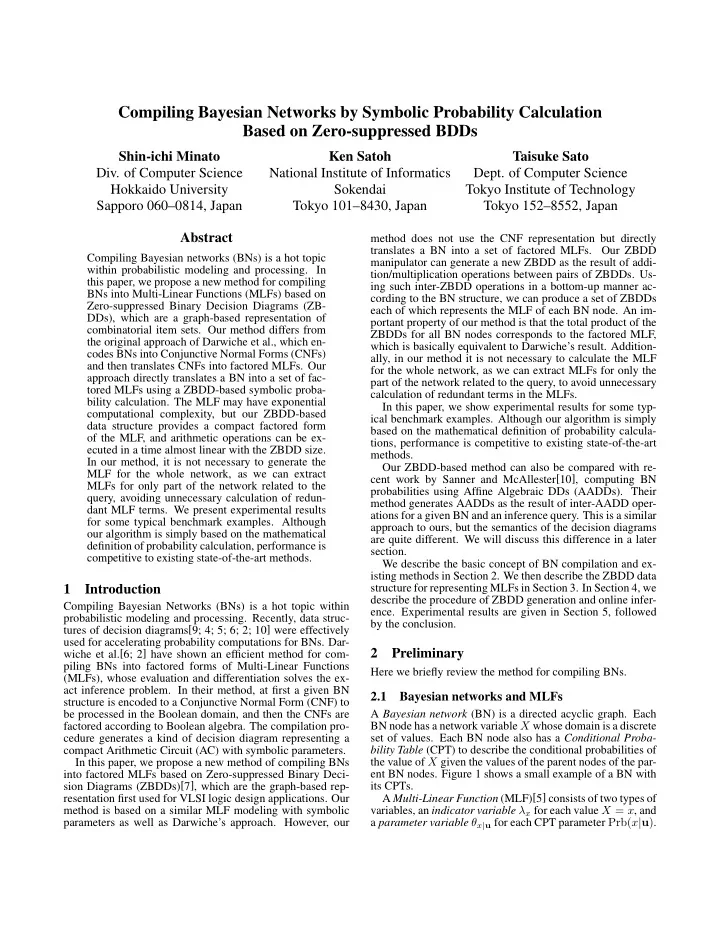

Compiling Bayesian Networks by Symbolic Probability Calculation Based on Zero-suppressed BDDs Shin-ichi Minato Ken Satoh Taisuke Sato Div. of Computer Science National Institute of Informatics Dept. of Computer Science Hokkaido University Sokendai Tokyo Institute of Technology Sapporo 060–0814, Japan Tokyo 101–8430, Japan Tokyo 152–8552, Japan Abstract method does not use the CNF representation but directly translates a BN into a set of factored MLFs. Our ZBDD Compiling Bayesian networks (BNs) is a hot topic manipulator can generate a new ZBDD as the result of addi- within probabilistic modeling and processing. In tion/multiplication operations between pairs of ZBDDs. Us- this paper, we propose a new method for compiling ing such inter-ZBDD operations in a bottom-up manner ac- BNs into Multi-Linear Functions (MLFs) based on cording to the BN structure, we can produce a set of ZBDDs Zero-suppressed Binary Decision Diagrams (ZB- each of which represents the MLF of each BN node. An im- DDs), which are a graph-based representation of portant property of our method is that the total product of the combinatorial item sets. Our method differs from ZBDDs for all BN nodes corresponds to the factored MLF, the original approach of Darwiche et al., which en- which is basically equivalent to Darwiche’s result. Addition- codes BNs into Conjunctive Normal Forms (CNFs) ally, in our method it is not necessary to calculate the MLF and then translates CNFs into factored MLFs. Our for the whole network, as we can extract MLFs for only the approach directly translates a BN into a set of fac- part of the network related to the query, to avoid unnecessary tored MLFs using a ZBDD-based symbolic proba- calculation of redundant terms in the MLFs. bility calculation. The MLF may have exponential In this paper, we show experimental results for some typ- computational complexity, but our ZBDD-based ical benchmark examples. Although our algorithm is simply data structure provides a compact factored form based on the mathematical definition of probability calcula- of the MLF, and arithmetic operations can be ex- tions, performance is competitive to existing state-of-the-art ecuted in a time almost linear with the ZBDD size. methods. In our method, it is not necessary to generate the Our ZBDD-based method can also be compared with re- MLF for the whole network, as we can extract cent work by Sanner and McAllester[10], computing BN MLFs for only part of the network related to the probabilities using Affine Algebraic DDs (AADDs). Their query, avoiding unnecessary calculation of redun- method generates AADDs as the result of inter-AADD oper- dant MLF terms. We present experimental results ations for a given BN and an inference query. This is a similar for some typical benchmark examples. Although approach to ours, but the semantics of the decision diagrams our algorithm is simply based on the mathematical are quite different. We will discuss this difference in a later definition of probability calculation, performance is section. competitive to existing state-of-the-art methods. We describe the basic concept of BN compilation and ex- isting methods in Section 2. We then describe the ZBDD data structure for representing MLFs in Section 3. In Section 4, we 1 Introduction describe the procedure of ZBDD generation and online infer- Compiling Bayesian Networks (BNs) is a hot topic within ence. Experimental results are given in Section 5, followed probabilistic modeling and processing. Recently, data struc- by the conclusion. tures of decision diagrams[9; 4; 5; 6; 2; 10] were effectively used for accelerating probability computations for BNs. Dar- 2 Preliminary wiche et al.[6; 2] have shown an efficient method for com- piling BNs into factored forms of Multi-Linear Functions Here we briefly review the method for compiling BNs. (MLFs), whose evaluation and differentiation solves the ex- act inference problem. In their method, at first a given BN 2.1 Bayesian networks and MLFs structure is encoded to a Conjunctive Normal Form (CNF) to A Bayesian network (BN) is a directed acyclic graph. Each be processed in the Boolean domain, and then the CNFs are BN node has a network variable X whose domain is a discrete factored according to Boolean algebra. The compilation pro- cedure generates a kind of decision diagram representing a set of values. Each BN node also has a Conditional Proba- compact Arithmetic Circuit (AC) with symbolic parameters. bility Table (CPT) to describe the conditional probabilities of the value of X given the values of the parent nodes of the par- In this paper, we propose a new method of compiling BNs ent BN nodes. Figure 1 shows a small example of a BN with into factored MLFs based on Zero-suppressed Binary Deci- sion Diagrams (ZBDDs)[7], which are the graph-based rep- its CPTs. A Multi-Linear Function (MLF)[5] consists of two types of resentation first used for VLSI logic design applications. Our method is based on a similar MLF modeling with symbolic variables, an indicator variable λ x for each value X = x , and a parameter variable θ x | u for each CPT parameter Prb( x | u ) . parameters as well as Darwiche’s approach. However, our
Recommend
More recommend